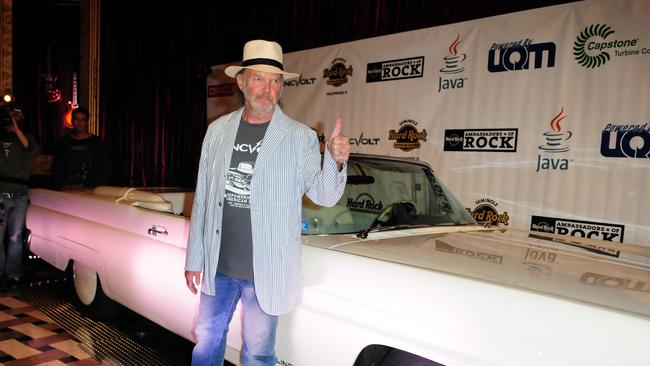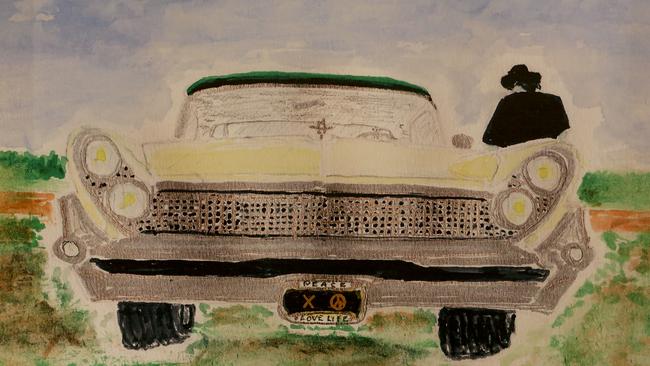Pretending EVs can turn the great Australian road trip into a pilgrimage of personal development defies reality
Their advocates wax lyrical but electric vehicles can’t replace reliable transport any time soon.

Neil Young’s classic ballad was written in memory of his 1948 Buick hearse, and it is not difficult to imagine electric vehicle drivers singing it out loud now as they strive to reach the next charging station – “With your chrome heart shining in the sun, long may you run”.
That is, if they dare to play music while they drive. It might be better to save the power for the engine.
Even for those of us who are not really petrolheads, cars are a huge part of our lives. From our teenage years they are freedom and independence. They take us to our most vital places and events, we have many of our most memorable conversations, and more, inside them, and their style and contents tend to reflect something of our own character.
And now we are told there is a righteous vibe developing around EVs. Apparently we can see this “new kind of driving culture” at charging stations, where the virtuous gather around their expensive vehicles.
“Drivers share tips on stations and stop-offs, offer to plug in others’ cars once their own is charged or gather to help a new owner figure the whole thing out,” Bianca Nogrady writes in Guardian Australia. This is “changing the Australian roadscape”.
Nogrady’s piece describes how a bemused couple with a new Lexus EV receives help from strangers. She interprets this as a utopian contrast to the dystopian world of petrol-fuelled inhumanity. Woodstock versus Mad Max.
“Motorists are not generally known for their community spirit and small acts of kindness,” she writes. “But around electric vehicle charging stations – whether on a regional highway, outside a cafe or in the centre of a busy city – a strange and wonderful communal vibe is developing.”
As we know, renewable energy enthusiasts and climate alarmists are not renowned for maintaining a close association with the facts and reality.
Could it be that EV advocates fall into the same category?
It seems so. For starters, given 90 per cent or more of Australians are “motorists”, it would seem to be wildly inaccurate to suggest they typically lack kindness and community spirit.
Let us call this slur out for what it is, the typical ploy of the virtue signaller where they demonise others to assert their own superiority. If you rely on internal combustion engines, apparently you are selfish and unkind; drive an EV and you are one step shy of beatification.
Still, if we chat with friends who drive EVs or look around on social media we can get a different impression. There are shouting matches as drivers accuse each other of queue-jumping at charging stations, long waits, local tricks to claim the shopping centre plug-ins, exasperation at broken chargers and incorrect plugs, and frustration and desperation about battery range and distances to the next charge. In Colorado earlier this year there was even a fatal shooting at a charging station (no charges have been laid and there were suggestions of an earlier road rage incident).
To be clear, you would have to be nuts to hold any grudges against EVs; they are wonderful pieces of engineering. As a city runabout, especially if you have off-street parking with home charging, they are a highly practical option.
But pretending they are turning the great Australian road trip into a pilgrimage of personal development, where roadhouses are more like ashrams and time is a foreign concept, defies reality. This has about as much credibility as claiming we can run our entire national grid on renewable energy.
Nogrady romanticises a recharging stop in Goulburn on a drive from Sydney to Canberra. I have done this three-hour drive countless times and normally do not stop at all or grab a quick roadhouse coffee; it is a closer to a commute than a road trip. Pulling off the highway to waste an hour recharging in Goulburn might be fine if you are heading for a weekend at Floriade but not if you want to make a 9am meeting.
At least Nogrady admits the “communal spirit” might dissipate as demand grows and wait times stretch. I wonder if she stopped to think about how her EV comrades were relying mainly on coal-fired energy; for the foreseeable future, without coal and gas, the EV dream would fall as flat as a Snowy 2.0 tunnel.
Across the past century cars have become so intrinsic in our lives that we know people might judge us according to what we drive; like our clothes, our wheels say something about us. This has embarrassed me once or twice, like when I drove Malcolm Turnbull’s Prius back from Canberra (and had to turn off for petrol on the urban fringe lest I run out of battery power in the M5 tunnel).

I live within 5km of the Sydney CBD, and the rise of EVs is obvious in my neck of the woods – Teslas are not exactly ubiquitous but are about as common as Audis or Volvos. Driving around Paramatta and then out to Penrith earlier this week I did not notice any – the busy motorways and roads were full of diesel trucks, vans and utes as well as petrol-driven SUVs and sedans of every persuasion.
The volume of vehicles, the hectic industriousness of it all underscored how far-fetched the talk is about an EV revolution.
Our entire economy relies on road transport and they need to keep going with the ability for quick refuelling stops whenever required – electrifying them all is a task almost beyond comprehension, yet we pretend it can happen quickly, conveniently and without sending us broke. On current technology, without compulsion, the switch to an EV and charging station model makes little practical sense.
Roads, and to a lesser extent railways, airways and shipping lanes, are the arteries of our economy and the idea that they will soon be reliant on the wind or sunshine or the ability to store variable renewable energy in a battery is delusional.
If we were serious about improving the efficiency of our transport system and lowering emissions, we would be upgrading our railways and rail/road hubs to ensure a much greater proportion of our freight is carried by rail which, by the way, can be electrified relatively easily. I guess this just does not sound sexy enough.
It is an unavoidable fact that EVs are an extraordinary drain on our resources.
Associate professor Simon Michaux from Finland Geological Survey calculates an EV requires six to seven times the mineral resources used in a conventional vehicle, with quantities of lithium, cobalt, copper, nickel, cobalt, graphite, and the list goes on.
Michaux has assessed these resource requirements and those for wind turbines, solar panels, batteries and the like to determine what is required to reach net zero. The demand is so far beyond current capacity, and in some cases known reserves, that it is most likely impossible.
Take something as common and essential as copper; current global production is about 22 million tonnes and at that level producing the 4.5 billion tonnes required for the net-zero task will take almost 200 years. Yet politicians constantly seek re-election making promises about net zero by 2050.
The task is even more difficult for other minerals.
More than a billion tonnes of nickel will be required and with current annual global production below three million tonnes, this represents close to 400 years of current output.
With lithium and cobalt, Michaux’s estimates run beyond 1000 years. The investment, infrastructure and energy required to ramp up production of these resources is mind-boggling and is already reflected in escalating costs.
Young, by the way, is an environmentalist as well as a car enthusiast and has spent millions trying to marry his green credentials with the American love of big cars and long road trips by turning a 2.5 tonne 1959 Lincoln Continental into an electric/alternative-fuel hybrid vehicle. There has been much engineering, a fire and remodelling of LincVolt, as the car is dubbed, and Young has been stranded on the highway with his partner Daryl Hannah after LincVolt broke down. Long may it run.








It was a little discombobulating as a teenager to realise Long May You Run was not a song of goodwill to a past love but an ode to a car.